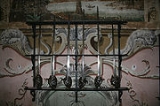
Basket-hilted sword
Encyclopedia
The basket-hilted sword is the name of a group of early modern sword
types characterized by a basket-shaped guard that protects the hand. The basket hilt is a development of the quillon
s added to swords' crossguards since the Late Middle Ages. Also known as the broadsword, the basket-hilted sword was a military sword, termed "broad" in contrast with the rapier
, the slim dueling sword worn with civilian dress during the same period.
up to the Napoleonic era
.
One of the earliest basket-hilted swords was recovered from the wreck of the Mary Rose
, an English warship lost in 1545. Before the find, the earliest positive dating had been two swords from around the time of the English Civil War
.
At first the wire guard was a simple design but as time passed it became increasingly sculpted and ornate.
The basket-hilted sword or broadsword was a heavy military sword, contrasting with rapier
, the light sword worn with civilian dress which evolved from the espada ropera
or spada da lato type during the same period.
Since the blade of the rapier had become narrow and thrust-oriented, the heavier blades became known as "broadsword".
By the 17th century there were regional variations of basket-hilts: the Walloon hilt, the Sinclair hilt, schiavona, mortuary sword, Scottish broadsword or "claymore" (also "claybeg"), and some types of eastern European pallasches.
The mortuary and claymore types two were common in Britain, whether domestically-produced or acquired through trade with Italy and Germany. They also influenced the 18th-century cavalry sabre
.
During the 18th century, the fashion of duel
ing in Europe focussed on the light smallsword, and fencing with the broadsword came to be seen as a speciality of Scotland
. A number of fencing manuals teaching fencing with the Scottish broadsword were published throughout the 18th century.
Descendants of the basket-hilted sword, albeit in the form of backsword
s with reduced "half" or "three-quarter" baskets, remained in use in cavalry during the Napoleonic era and throughout the 19th century, specifically as the 1796 Heavy Cavalry Sword, the Gothic Hilted British Infantry Swords
of the 1820s to 1890s, the 1897 Pattern British Infantry Officer's Sword
and as the Pattern 1908 and 1912 cavalry swords down to the eve of World War I
.
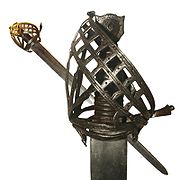 The Schiavona was a Renaissance
The Schiavona was a Renaissance
sword that became popular in Italy
during the 16th and 17th centuries. Stemming from the 16th-century sword of the Balkan mercenaries who formed the bodyguard of the Doge of Venice
, the name came from the fact that the guard consisted largely of Istrian and Dalmatian Slavs
(Schiavoni). It was widely recognisable for its "cat's-head pommel" and distinctive handguard made up of many leaf-shaped brass or iron bars that was attached to the cross-bar and knucklebow rather than the pommel.
Classified as a true broadsword, this war sword had a wider blade than its contemporary civilian rapier
s. It was basket hilted (often with an imbedded quillon for an upper guard) and its blade was double edged. A surviving blade measures 93.2 cm × 3.4 cm × 0.45 cm and bears two fullers
or grooves running about 1/4 the length of the blade. Weighing in at around 1.1 kg, this blade was useful for both cut and thrust.
The schiavona became popular among the armies of those who traded with Italy during the 17th century and was the weapon of choice for many heavy cavalry
. It was popular among mercenary soldiers and wealthy civilians alike; examples decorated with gilding and precious stones were imported by the upper classes to be worn as a combination of fashion accessory and defensive weapon.
during the English Civil War
. This (usually) two-edged sword sported a half-basket hilt with a straight blade some 90–105 cm long. These hilts were often of very intricate sculpting and design.
After the execution of King Charles I
(1649), basket-hilted swords were made which depicted the face or death mask of the "martyred" king on the hilt. These swords came to be known as "mortuary swords", and the term has been extended to refer to the entire type of Civil War era broadswords by some 20th century authors.
This sword was Oliver Cromwell
's weapon of choice; the one he owned is now preserved in the Royal Armouries Museum in Leeds. Mortuary swords remained in use until around 1670 when they fell out of favor among civilians and began to be replaced with the smallsword.
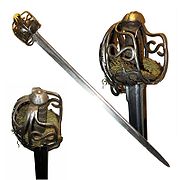
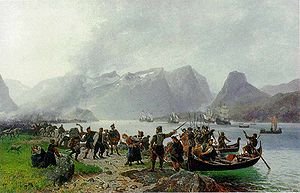 The Sinclair Hilt was one of the earliest basket-hilt designs and was of south German origin. On average the blade of a Sinclair or "compound" hilt sword measured 38in.
The Sinclair Hilt was one of the earliest basket-hilt designs and was of south German origin. On average the blade of a Sinclair or "compound" hilt sword measured 38in.
It had long quillon
s and an oval leather-wrapped grip that was originally designed for falchion
blades but was soon applied to the broadsword. It had a large triangular plate very similar to the ones used on main gauche daggers and was decorated with pierced hearts and diamonds.
Hilts of this design were also used on other weapons including sabres, cutlass
es, rapiers, backswords and civilian hunting hangers.
A similar weapon was the Pallasch which had the same hilt and straight blade but was single-edged. It was used until the mid-18th century by the Austrian army and inspired the British 1796 Heavy Cavalry Sabre.
It is believed that these swords were brought back to Scotland by George Sinclair
's mercenaries who had served on the continent.
The Sinclair hilt broadsword influenced the development of the Scottish basket-hilted claymore, which was used by highlanders
in the 17th and 18th century. After the Jacobite Wars it became a symbol of Scotland
.
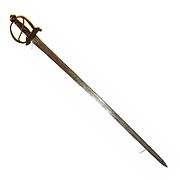 The so-called walloon sword (épée wallone) was common in Germany, Switzerland
The so-called walloon sword (épée wallone) was common in Germany, Switzerland
, the Netherlands
and Scandinavia
in the Thirty Years' War
and Baroque
era.
Basket-hilted rapiers made during the same period are known as Pappenheimer rapiers.
The Walloon sword was favored by both the military and civilian gentry for its versatility: it was light, flexible, and good for both cutting and thrusting as well as the more accurate pointwork required in duel
s with rapier
s. Its hilt was ambidextrous with shell-guards and knuckle-bow that inspired 18th century continental hunting hangers.
Following their campaign in the Netherlands in 1672 (when many of these German-made swords were captured from the Dutch), the French began producing this weapon as their first regulation sword. Weapons of this design were also issued to the Swedish army
from the time of Gustavus Adolphus until as late as the 1850s.
in his Paradoxes of Defence (1599), published some material on broadswords, but no instructive details. Two later books by Silver, Brief Instructions on my Paradoxes of Defence, and Rules of Defence to be observed in open Fyght, &c., contained more detailed instructions in the use of the broadsword. Silver advises three principal "fyghts", or stances for attack, one with the hilt held above the wielder's head with the point towards the wielder's knee; the second with the wielder's hilt just below chest level with the point towards the wielder's left foot; and the third having the hands held low and the point held upright. The "wards" or parries
were made from these middle positions by moving the sword to the right or left. Silver was also the first author of any nationality to distinctly advocate parrying and riposting
, to which he devoted an entire chapter.
Sword
A sword is a bladed weapon used primarily for cutting or thrusting. The precise definition of the term varies with the historical epoch or the geographical region under consideration...
types characterized by a basket-shaped guard that protects the hand. The basket hilt is a development of the quillon
Quillón
Quillón is a Chilean city and commune and Ñuble Province, Biobío Region.-Demographics:According to the 2002 census of the National Statistics Institute, Quillón spans an area of and has 15,146 inhabitants . Of these, 7,536 lived in urban areas and 7,610 in rural areas...
s added to swords' crossguards since the Late Middle Ages. Also known as the broadsword, the basket-hilted sword was a military sword, termed "broad" in contrast with the rapier
Rapier
A rapier is a slender, sharply pointed sword, ideally used for thrusting attacks, used mainly in Early Modern Europe during the 16th and 17th centuries.-Description:...
, the slim dueling sword worn with civilian dress during the same period.
Morphology
The basket-hilted sword is a development of the 16th century, rising to popularity in the 17th century and remaining in widespread use throughout the 18th century, used especially by heavy cavalryHeavy cavalry
Heavy cavalry is a class of cavalry whose primary role was to engage in direct combat with enemy forces . Although their equipment differed greatly depending on the region and historical period, they were generally mounted on large powerful horses, and were often equipped with some form of scale,...
up to the Napoleonic era
Napoleonic Era
The Napoleonic Era is a period in the history of France and Europe. It is generally classified as including the fourth and final stage of the French Revolution, the first being the National Assembly, the second being the Legislative Assembly, and the third being the Directory...
.
One of the earliest basket-hilted swords was recovered from the wreck of the Mary Rose
Mary Rose
The Mary Rose was a carrack-type warship of the English Tudor navy of King Henry VIII. After serving for 33 years in several wars against France, Scotland, and Brittany and after being substantially rebuilt in 1536, she saw her last action on 1545. While leading the attack on the galleys of a...
, an English warship lost in 1545. Before the find, the earliest positive dating had been two swords from around the time of the English Civil War
English Civil War
The English Civil War was a series of armed conflicts and political machinations between Parliamentarians and Royalists...
.
At first the wire guard was a simple design but as time passed it became increasingly sculpted and ornate.
The basket-hilted sword or broadsword was a heavy military sword, contrasting with rapier
Rapier
A rapier is a slender, sharply pointed sword, ideally used for thrusting attacks, used mainly in Early Modern Europe during the 16th and 17th centuries.-Description:...
, the light sword worn with civilian dress which evolved from the espada ropera
Espada ropera
The espada ropera was a sword developed in the mid-15th century in Spain. The name referred to swords worn by civilians, as opposed for those meant for battlefield use. Compared to earlier swords, the espada ropera was lighter, thinner, and more ornate. It was first mentioned in an inventory of Don...
or spada da lato type during the same period.
Since the blade of the rapier had become narrow and thrust-oriented, the heavier blades became known as "broadsword".
By the 17th century there were regional variations of basket-hilts: the Walloon hilt, the Sinclair hilt, schiavona, mortuary sword, Scottish broadsword or "claymore" (also "claybeg"), and some types of eastern European pallasches.
The mortuary and claymore types two were common in Britain, whether domestically-produced or acquired through trade with Italy and Germany. They also influenced the 18th-century cavalry sabre
Sabre
The sabre or saber is a kind of backsword that usually has a curved, single-edged blade and a rather large hand guard, covering the knuckles of the hand as well as the thumb and forefinger...
.
During the 18th century, the fashion of duel
Duel
A duel is an arranged engagement in combat between two individuals, with matched weapons in accordance with agreed-upon rules.Duels in this form were chiefly practised in Early Modern Europe, with precedents in the medieval code of chivalry, and continued into the modern period especially among...
ing in Europe focussed on the light smallsword, and fencing with the broadsword came to be seen as a speciality of Scotland
Scotland
Scotland is a country that is part of the United Kingdom. Occupying the northern third of the island of Great Britain, it shares a border with England to the south and is bounded by the North Sea to the east, the Atlantic Ocean to the north and west, and the North Channel and Irish Sea to the...
. A number of fencing manuals teaching fencing with the Scottish broadsword were published throughout the 18th century.
Descendants of the basket-hilted sword, albeit in the form of backsword
Backsword
A backsword is a sword with a blade on one edge, or an "edge-and-a-quarter." The back of the sword is often the thickest part of the blade and acts to support and strengthen it....
s with reduced "half" or "three-quarter" baskets, remained in use in cavalry during the Napoleonic era and throughout the 19th century, specifically as the 1796 Heavy Cavalry Sword, the Gothic Hilted British Infantry Swords
Gothic Hilted British Infantry Swords (1822, 1827, 1845, 1854 and 1892 Patterns)
The gothic hilted swords were a family of swords carried by officers and some NCOs of the British Army between 1822 and the present day. They were primarily infantry swords, although they were also regulation pattern for some other officers such as surgeons and staff officers...
of the 1820s to 1890s, the 1897 Pattern British Infantry Officer's Sword
1897 Pattern British Infantry Officer's Sword
The 1897 Pattern Infantry Officers’ Sword is a straight-bladed, three-quarter basket hilted sword that has been the regulation sword for officers of the line infantry of the British Army from 1897 to the present day.-History:...
and as the Pattern 1908 and 1912 cavalry swords down to the eve of World War I
World War I
World War I , which was predominantly called the World War or the Great War from its occurrence until 1939, and the First World War or World War I thereafter, was a major war centred in Europe that began on 28 July 1914 and lasted until 11 November 1918...
.
Schiavona

Renaissance
The Renaissance was a cultural movement that spanned roughly the 14th to the 17th century, beginning in Italy in the Late Middle Ages and later spreading to the rest of Europe. The term is also used more loosely to refer to the historical era, but since the changes of the Renaissance were not...
sword that became popular in Italy
Italy
Italy , officially the Italian Republic languages]] under the European Charter for Regional or Minority Languages. In each of these, Italy's official name is as follows:;;;;;;;;), is a unitary parliamentary republic in South-Central Europe. To the north it borders France, Switzerland, Austria and...
during the 16th and 17th centuries. Stemming from the 16th-century sword of the Balkan mercenaries who formed the bodyguard of the Doge of Venice
Doge of Venice
The Doge of Venice , often mistranslated Duke was the chief magistrate and leader of the Most Serene Republic of Venice for over a thousand years. Doges of Venice were elected for life by the city-state's aristocracy. Commonly the person selected as Doge was the shrewdest elder in the city...
, the name came from the fact that the guard consisted largely of Istrian and Dalmatian Slavs
South Slavs
The South Slavs are the southern branch of the Slavic peoples and speak South Slavic languages. Geographically, the South Slavs are native to the Balkan peninsula, the southern Pannonian Plain and the eastern Alps...
(Schiavoni). It was widely recognisable for its "cat's-head pommel" and distinctive handguard made up of many leaf-shaped brass or iron bars that was attached to the cross-bar and knucklebow rather than the pommel.
Classified as a true broadsword, this war sword had a wider blade than its contemporary civilian rapier
Rapier
A rapier is a slender, sharply pointed sword, ideally used for thrusting attacks, used mainly in Early Modern Europe during the 16th and 17th centuries.-Description:...
s. It was basket hilted (often with an imbedded quillon for an upper guard) and its blade was double edged. A surviving blade measures 93.2 cm × 3.4 cm × 0.45 cm and bears two fullers
Fuller (weapon)
A fuller is a rounded or beveled groove or slot in the flat side of a blade . A fuller is often used to lighten the blade, much in the way that an I-beam shape allows a given amount of strength to be achieved with less material...
or grooves running about 1/4 the length of the blade. Weighing in at around 1.1 kg, this blade was useful for both cut and thrust.
The schiavona became popular among the armies of those who traded with Italy during the 17th century and was the weapon of choice for many heavy cavalry
Heavy cavalry
Heavy cavalry is a class of cavalry whose primary role was to engage in direct combat with enemy forces . Although their equipment differed greatly depending on the region and historical period, they were generally mounted on large powerful horses, and were often equipped with some form of scale,...
. It was popular among mercenary soldiers and wealthy civilians alike; examples decorated with gilding and precious stones were imported by the upper classes to be worn as a combination of fashion accessory and defensive weapon.
Mortuary sword
A similar weapon was the cut-and-thrust mortuary sword which was used after 1625 by cavalryCavalry
Cavalry or horsemen were soldiers or warriors who fought mounted on horseback. Cavalry were historically the third oldest and the most mobile of the combat arms...
during the English Civil War
English Civil War
The English Civil War was a series of armed conflicts and political machinations between Parliamentarians and Royalists...
. This (usually) two-edged sword sported a half-basket hilt with a straight blade some 90–105 cm long. These hilts were often of very intricate sculpting and design.
After the execution of King Charles I
Charles I of England
Charles I was King of England, King of Scotland, and King of Ireland from 27 March 1625 until his execution in 1649. Charles engaged in a struggle for power with the Parliament of England, attempting to obtain royal revenue whilst Parliament sought to curb his Royal prerogative which Charles...
(1649), basket-hilted swords were made which depicted the face or death mask of the "martyred" king on the hilt. These swords came to be known as "mortuary swords", and the term has been extended to refer to the entire type of Civil War era broadswords by some 20th century authors.
This sword was Oliver Cromwell
Oliver Cromwell
Oliver Cromwell was an English military and political leader who overthrew the English monarchy and temporarily turned England into a republican Commonwealth, and served as Lord Protector of England, Scotland, and Ireland....
's weapon of choice; the one he owned is now preserved in the Royal Armouries Museum in Leeds. Mortuary swords remained in use until around 1670 when they fell out of favor among civilians and began to be replaced with the smallsword.
Scottish broadsword

Sinclair Hilt

It had long quillon
Quillón
Quillón is a Chilean city and commune and Ñuble Province, Biobío Region.-Demographics:According to the 2002 census of the National Statistics Institute, Quillón spans an area of and has 15,146 inhabitants . Of these, 7,536 lived in urban areas and 7,610 in rural areas...
s and an oval leather-wrapped grip that was originally designed for falchion
Falchion
A falchion is a one-handed, single-edged sword of European origin, whose design is reminiscent of the Persian scimitar and the Chinese dao....
blades but was soon applied to the broadsword. It had a large triangular plate very similar to the ones used on main gauche daggers and was decorated with pierced hearts and diamonds.
Hilts of this design were also used on other weapons including sabres, cutlass
Cutlass
A cutlass is a short, broad sabre or slashing sword, with a straight or slightly curved blade sharpened on the cutting edge, and a hilt often featuring a solid cupped or basket shaped guard...
es, rapiers, backswords and civilian hunting hangers.
A similar weapon was the Pallasch which had the same hilt and straight blade but was single-edged. It was used until the mid-18th century by the Austrian army and inspired the British 1796 Heavy Cavalry Sabre.
It is believed that these swords were brought back to Scotland by George Sinclair
George Sinclair (mercenary)
George Sinclair was a Scottish mercenary who fought in the Kalmar War, and was posthumously remembered in Norway. In Norway, his name is often rendered Sinklar.-Early life:...
's mercenaries who had served on the continent.
The Sinclair hilt broadsword influenced the development of the Scottish basket-hilted claymore, which was used by highlanders
Scottish Highlands
The Highlands is an historic region of Scotland. The area is sometimes referred to as the "Scottish Highlands". It was culturally distinguishable from the Lowlands from the later Middle Ages into the modern period, when Lowland Scots replaced Scottish Gaelic throughout most of the Lowlands...
in the 17th and 18th century. After the Jacobite Wars it became a symbol of Scotland
Scotland
Scotland is a country that is part of the United Kingdom. Occupying the northern third of the island of Great Britain, it shares a border with England to the south and is bounded by the North Sea to the east, the Atlantic Ocean to the north and west, and the North Channel and Irish Sea to the...
.
Walloon sword

Early Modern Switzerland
The early modern history of the Old Swiss Confederacy , lasting from formal independence in 1648 to the French invasion of 1798 came to be referred as Ancien Régime retrospectively, in post-Napoleonic Switzerland.The early modern period was characterized by an increasingly...
, the Netherlands
Dutch Republic
The Dutch Republic — officially known as the Republic of the Seven United Netherlands , the Republic of the United Netherlands, or the Republic of the Seven United Provinces — was a republic in Europe existing from 1581 to 1795, preceding the Batavian Republic and ultimately...
and Scandinavia
Swedish Empire
The Swedish Empire refers to the Kingdom of Sweden between 1561 and 1721 . During this time, Sweden was one of the great European powers. In Swedish, the period is called Stormaktstiden, literally meaning "the Great Power Era"...
in the Thirty Years' War
Thirty Years' War
The Thirty Years' War was fought primarily in what is now Germany, and at various points involved most countries in Europe. It was one of the most destructive conflicts in European history....
and Baroque
Baroque
The Baroque is a period and the style that used exaggerated motion and clear, easily interpreted detail to produce drama, tension, exuberance, and grandeur in sculpture, painting, literature, dance, and music...
era.
Basket-hilted rapiers made during the same period are known as Pappenheimer rapiers.
The Walloon sword was favored by both the military and civilian gentry for its versatility: it was light, flexible, and good for both cutting and thrusting as well as the more accurate pointwork required in duel
Duel
A duel is an arranged engagement in combat between two individuals, with matched weapons in accordance with agreed-upon rules.Duels in this form were chiefly practised in Early Modern Europe, with precedents in the medieval code of chivalry, and continued into the modern period especially among...
s with rapier
Rapier
A rapier is a slender, sharply pointed sword, ideally used for thrusting attacks, used mainly in Early Modern Europe during the 16th and 17th centuries.-Description:...
s. Its hilt was ambidextrous with shell-guards and knuckle-bow that inspired 18th century continental hunting hangers.
Following their campaign in the Netherlands in 1672 (when many of these German-made swords were captured from the Dutch), the French began producing this weapon as their first regulation sword. Weapons of this design were also issued to the Swedish army
Swedish Army
The Swedish Army is one of the oldest standing armies in the world and a branch of the Swedish Armed Forces; it is in charge of land operations. General Sverker Göranson is the Supreme Commander-in-Chief of the Army.- Organization :...
from the time of Gustavus Adolphus until as late as the 1850s.
Fencing technique
George SilverGeorge Silver
George Silver was a gentleman of England during the late 16th and early 17th centuries, who is known for his writings on fencing. He is thought to have been the eldest of four brothers , and eleventh in descent from Sir Bartholomew Silver, who was knighted by Edward II...
in his Paradoxes of Defence (1599), published some material on broadswords, but no instructive details. Two later books by Silver, Brief Instructions on my Paradoxes of Defence, and Rules of Defence to be observed in open Fyght, &c., contained more detailed instructions in the use of the broadsword. Silver advises three principal "fyghts", or stances for attack, one with the hilt held above the wielder's head with the point towards the wielder's knee; the second with the wielder's hilt just below chest level with the point towards the wielder's left foot; and the third having the hands held low and the point held upright. The "wards" or parries
Parry (fencing)
A parry is a fencing bladework manoeuvre intended to deflect or block an incoming attack.-Execution:To execute a parry, fencers strike the opponent's foible, or the area near the tip of the blade, with their forte, or the part of the blade near the handle of the sword...
were made from these middle positions by moving the sword to the right or left. Silver was also the first author of any nationality to distinctly advocate parrying and riposting
Riposte
In fencing, the riposte is an offensive action with the intent of hitting one's opponent, made by the fencer who has just parried an attack....
, to which he devoted an entire chapter.
External links
- Collection of Early Modern swords at the Swedish Military History Museum (sfhm.se)
- The basket-hilted sword. Description and photos (interestingswords.com)
- Schiavona – Venetian basket-hilted sword (interestingswords.com)

